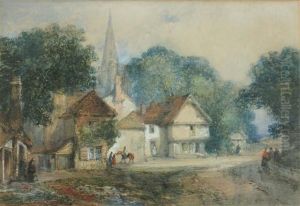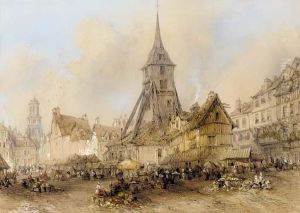Thomas Richard Coleman Dibdin Paintings
Thomas Richard Coleman Dibdin, born in 1810, was an English watercolour painter and illustrator, recognized for his maritime and landscape paintings. Dibdin's artistic journey was deeply influenced by his heritage and the vibrant cultural milieu of the 19th century. He was a descendant of the famed playwright and sea song writer, Charles Dibdin, which perhaps instilled in him a profound connection to the sea and maritime themes that would later become a central motif in his artistry.
Dibdin's early life was marked by his immersion in the study of art, though detailed records of his education are scarce. He showed a proclivity for watercolour, a medium that was gaining significant popularity in England during his time. This period saw the rise of the English watercolour movement, with artists exploring the versatility and expressiveness of watercolours in capturing landscapes, seascapes, and the transient effects of light and weather. Dibdin contributed to this movement with his delicate handling of the medium, his ability to capture the luminosity of water, and the dynamic character of the British coastline.
Throughout his career, Dibdin exhibited his works at various prestigious institutions, including the Royal Academy and the Society of British Artists, showcasing his proficiency in rendering maritime scenes that were both evocative and technically accomplished. His illustrations and paintings often depicted ships and coastal scenes, infused with a romanticism that resonated with the Victorian public's fascination with the sea as a realm of adventure and discovery.
Despite his contributions to the English watercolour tradition, Dibdin's work was somewhat overshadowed by the more prominent figures of his time, such as J.M.W. Turner and John Constable. However, his dedication to capturing the essence of the British landscape and seascape ensured that his paintings found a receptive audience, contributing to the era's burgeoning appreciation of watercolour as a serious artistic medium.
Thomas Richard Coleman Dibdin passed away in 1893, leaving behind a legacy that, while not as widely recognized as some of his contemporaries, remains significant for its contribution to the development of watercolour painting in England. His works continue to be appreciated by art historians and collectors for their technical skill, emotive power, and the window they provide into the maritime culture of the 19th century.



